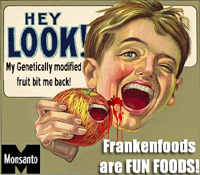
Week 5
One thing we did this week was the CSPI eye opener. I toured the food supply for this eye opener. The website I visited had a lot of interesting and hard to think about facts. Another thing we did this week was watch the Documentary "Diet for a new America". After hearing all of the facts from the documentaries and activities, it's really making me think a lot more about what I eat. I have even been trying to eat a little healthier and eat fast food less.
Week 6
This week we watched the documentary "Future of Food". this video showed some of the effects that farming can have on the environment and our health. This video was especialy interesting to me because I come from a small farm town. It made me mad to see the people from Monsanto sueing farmers for having thier seeds in their fields when they couldn't do anything to stop it from happening. I was also very surprised to learn that there is no law requiring products to be labled that contain genetically modified crops. I really think that more people need to have their eyes opened to this information.
One thing we did this week was the CSPI eye opener. I toured the food supply for this eye opener. The website I visited had a lot of interesting and hard to think about facts. Another thing we did this week was watch the Documentary "Diet for a new America". After hearing all of the facts from the documentaries and activities, it's really making me think a lot more about what I eat. I have even been trying to eat a little healthier and eat fast food less.
Week 6
This week we watched the documentary "Future of Food". this video showed some of the effects that farming can have on the environment and our health. This video was especialy interesting to me because I come from a small farm town. It made me mad to see the people from Monsanto sueing farmers for having thier seeds in their fields when they couldn't do anything to stop it from happening. I was also very surprised to learn that there is no law requiring products to be labled that contain genetically modified crops. I really think that more people need to have their eyes opened to this information.






